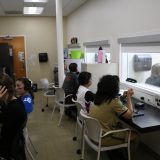
Navigating a Career in Physical Therapy
June 5, 2014
This article, written by Joe Yogerst, originally appeared on the Los Angeles Times website.
Business is set to boom for physical therapists. Employment in the sector is projected to grow 36% over the decade spanning 2012 to 2022, much faster than the average for all occupations, according to the U.S. Bureau of Labor Statistics. This means an increase of around 73,500 jobs that currently pay a median of $79,860 per year.
Daniel Cipriani
, an associate professor in the Department of Physical Therapy at Chapman University, cites several reasons for this rapid increase in demand. But the primary factor, he says, is passage of Direct Access legislation in many states.
Signed into law by Gov. Jerry Brown on Jan. 1 of this year, California’s Direct Access law means that physical therapy is no longer contingent upon the prescription or referral of a physician.
Another reason cited by Cipriani is the fact that more individuals over the age of 60 are involved in fitness, exercise and recreation these days, resulting in injuries. Meanwhile, more physical therapists are branching out into the health/wellness/prevention/fitness industries. And there is increasing evidence that physical therapy is effective for restoration of physical as well as mental function.
According to the Bureau of Labor Statistics, the PT job boom is also being fueled by an increase in people afflicted by chronic conditions like diabetes and obesity who require physical therapy to maintain their mobility. Thanks to medical and technological innovations, more trauma victims and newborns with birth defects are surviving, creating additional demand for rehabilitative care.
Last, but not least, the number of individuals seeking physical therapy may increase in the wake of health insurance reform in the Affordable Care Act.
Chapman University is well-positioned to meet the surging PT demand with one of the nation’s largest and oldest physical therapy programs, accredited since 1928. It offers an entry-level doctor of physical therapy (DPT) degree for students interested in becoming a physical therapy professional, as well as a transitional doctor of physical therapy (tDPT) degree for those already in the profession who desire a full DPT.
“The number of applicants for Chapman’s physical therapy programs has increased consistently over the past few years,” said Serena Healey, the university’s physical therapy admissions and special events coordinator.
Around 200 students are currently studying for their DPT at Chapman and more than 1,400 others have applied to enter the program. In order to accommodate this growing demand, Chapman has decided to offer both fall and spring intakes starting this year.
“Applicants are encouraged to have a strong prerequisite GPA and GRE scores,” Healey said. “Last year, our entering class had the highest average, historically, with a 3.7 prerequisite GPA and [an average] 156 verbal, 156 quantitative and 4.0 writing for the GRE.”
Cipriani suggested that undergraduates considering a DPT degree should meet with their college guidance counselors as early as possible to determine the right blend of undergraduate courses.
“Be prepared to work hard during the undergraduate years in order to maintain excellence in all course work,” he said.
The professor also said that anyone considering a physical therapy career should get their feet wet by “volunteering or shadowing in various settings such as outpatient, skilled nursing, pediatric. Watch how PTs interact with patients and clients to help restore movement and enhance quality of life.”
—Joe Yogerst, Brand Publishing Writer

